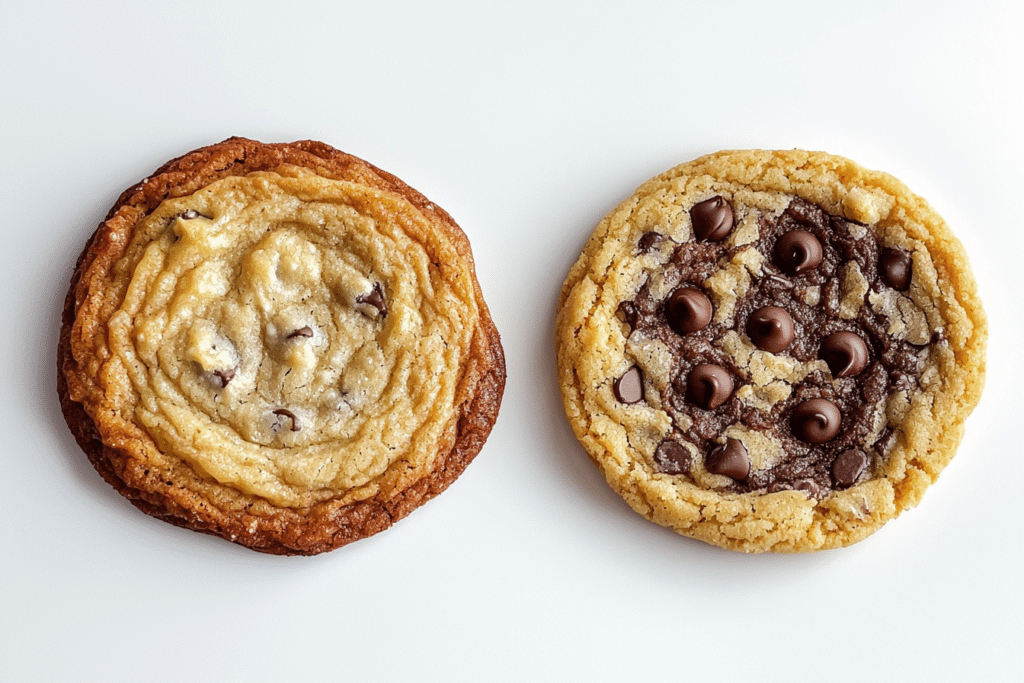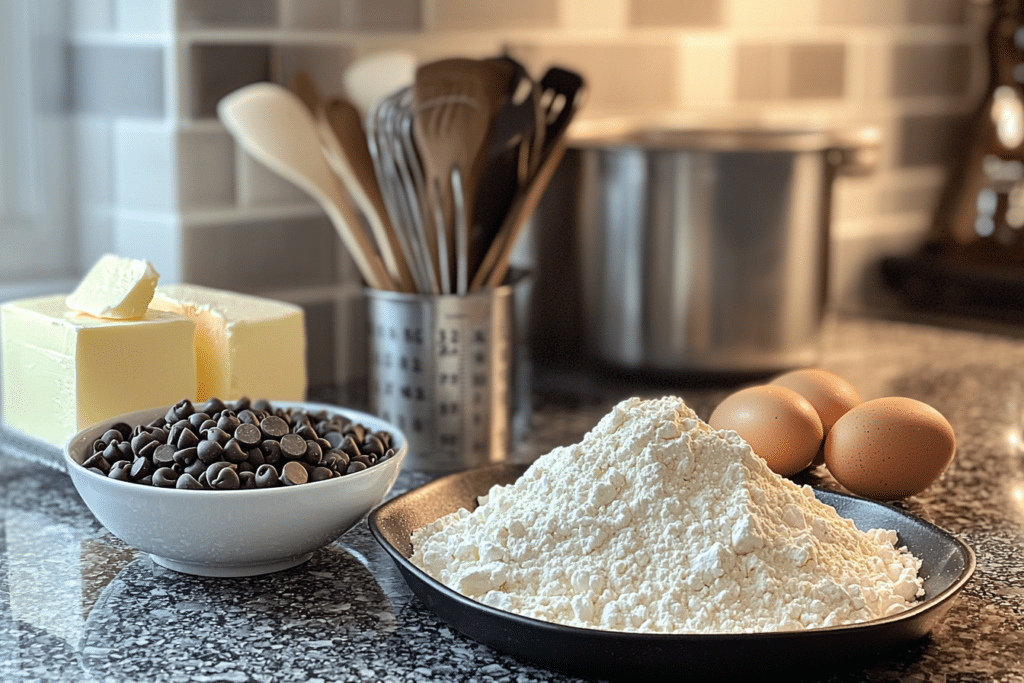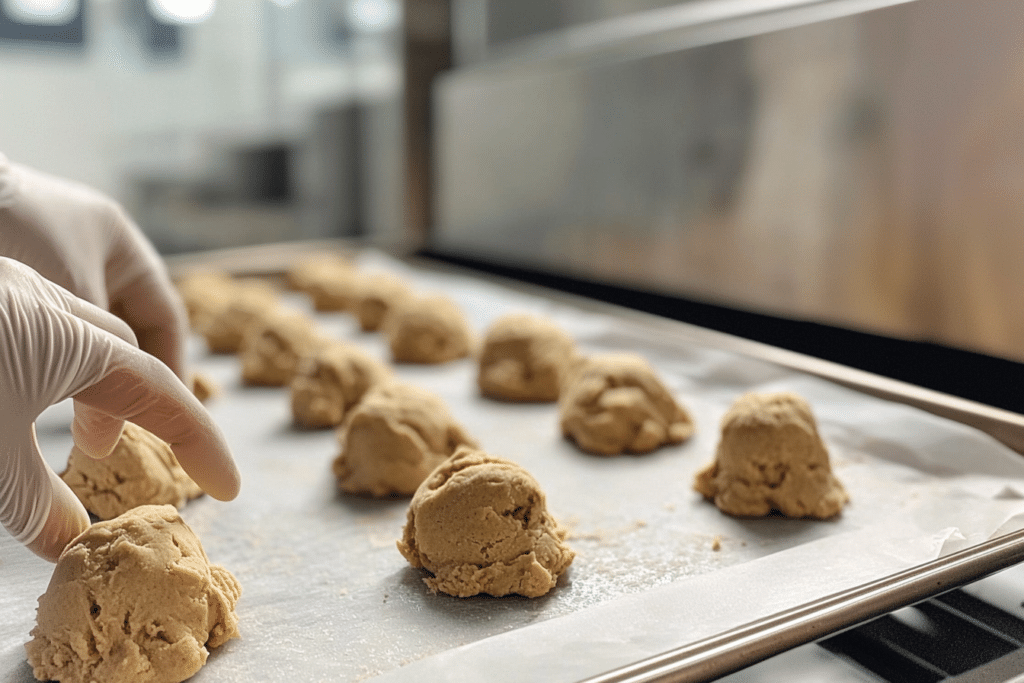1. Introduction
Have you ever wondered, ‘Why do my Nestle chocolate chip cookies go flat?’ This common issue frustrates bakers everywhere. Even when using the iconic recipe, cookies can sometimes spread too much, resulting in flat, less chewy treats. Understanding the causes of flat cookies can help you avoid this issue and bake perfect cookies every time. This common problem can be caused by a variety of factors, from ingredient ratios to preparation methods.
In this guide, we’ll dive into the science of perfect cookies, explore the most common reasons for flat cookies, and provide actionable solutions to help you bake picture-perfect cookies every time. For more baking inspiration, visit the Oven Warm Recipes Home to explore a variety of recipes.
2. The Science of Perfect Cookies
Understanding the science behind cookie baking can help prevent common issues like flat cookies. Learn more about the science of baking cookies here. Each ingredient and step in the process contributes to the structure, texture, and shape of the final product. Let’s break it down.
2.1 Importance of Ingredient Ratios
The balance of ingredients in a cookie recipe is critical. Here’s how each main component contributes:
- Flour: Provides the structure by forming gluten when mixed with wet ingredients. Too little flour results in cookies that spread excessively, while too much can make them dense and dry.
- Butter: Adds richness and helps cookies spread. If used in the wrong consistency (e.g., melted), it can lead to overly flat cookies.
- Sugar: Impacts both flavor and structure. Brown sugar retains moisture, creating chewiness, while granulated sugar promotes spreading.
- Eggs: Bind the ingredients together and add moisture. Using too few eggs may lead to spreading, while overusing them can make cookies cakey.
2.2 Impact of Temperature on Cookie Dough
Temperature affects every stage of cookie baking, from preparation to the oven:
- Butter Temperature: Butter that is too soft or melted will cause the dough to spread too quickly, resulting in flat cookies. On the other hand, butter that’s too cold can make the dough hard to mix evenly.
- Oven Temperature: Preheating your oven is crucial. An oven that isn’t hot enough will give the dough too much time to spread before it sets. Conversely, an oven that’s too hot can cause uneven baking.
Quick Tip: Always chill your cookie dough before baking. This helps the fat solidify and reduces spreading during baking.
3. Why Do My Nestle Chocolate Chip Cookies Go Flat? Common Causes
Flat cookies can be disappointing, but understanding the root causes can help you achieve the perfect texture and shape. Let’s explore the most common reasons for flat Nestle Toll House Chocolate Chip Cookies and how to avoid them.

3.1 Why Do My Nestle Chocolate Chip Cookies Go Flat? Common Butter Issues
Butter is a key ingredient in cookies, and its consistency greatly impacts the dough’s performance.
- Overly Soft or Melted Butter: When butter is too soft or melted, it breaks down the dough structure, causing the cookies to spread too much during baking.
- How to Fix It: Use butter that’s softened to room temperature but still firm. Press your finger lightly into the butter—it should leave a slight indent without sinking.
3.2 Lack of Flour: A Cause of Flat Nestle Cookies
Flour provides the structure that holds cookies together. When too little flour is used, the dough lacks the strength to maintain its shape.
- How to Fix It: Measure your flour accurately using the spoon-and-level method. If the dough feels sticky, add an extra tablespoon of flour at a time until the consistency improves.
3.3 How Overmixing Causes Nestle Cookies to Go Flat
Overmixing incorporates too much air into the dough, which can lead to cookies that rise in the oven and then deflate as they cool.
- How to Fix It: Mix just until the ingredients are combined. Avoid overworking the dough once the flour is added.
3.4 Skipping the Chill: Why Nestle Cookies Flatten During Baking
Chilling the dough solidifies the fat, preventing excessive spreading during baking. Skipping this step often results in thin, flat cookies.
- How to Fix It: Chill the dough for at least 30 minutes before baking. For even better results, refrigerate the dough overnight.
3.5 Wrong Oven Temperature and Flat Nestle Cookies
Oven temperature plays a critical role in cookie baking. If the oven is too cool, the cookies will spread too much before setting.
- How to Fix It: Preheat your oven to 375°F (190°C) and use an oven thermometer to ensure accuracy.
4. Step-by-Step Fixes
Now that we’ve identified the common reasons for flat cookies, let’s dive into actionable solutions. These steps will help you avoid mistakes and bake perfectly shaped Nestle Toll House Chocolate Chip Cookies every time.
4.1 How to Fix Butter Issues
Butter consistency is one of the most critical factors for cookie success:
- Softening Butter Correctly: Remove butter from the fridge about 30 minutes before baking. It should be soft enough to press your finger into but not so soft that it feels greasy or melty.
- Quick Softening Hack: Cut butter into small pieces and let it sit at room temperature for 10-15 minutes. Avoid microwaving, as this often causes uneven softening.
Pro Tip: If your butter gets too soft, chill the dough for 15 minutes before baking to firm it up. Follow the original Nestle chocolate chip cookie recipe for a perfect balance of ingredients.
4.2 Measuring Flour Properly

Accurate flour measurement prevents cookies from spreading too much:
- The Spoon-and-Level Method: Use a spoon to fill your measuring cup with flour, then level it off with a knife. Avoid packing the flour, as this can lead to dense cookies.
- Adjusting for Dough Texture: If your dough feels too wet or sticky, add 1 tablespoon of flour at a time until it holds its shape.
For tips on measuring flour accurately to avoid flat cookies, check out how to measure ingredients correctly.
4.3 The Right Way to Mix Ingredients
Overmixing can lead to air pockets in the dough, which cause cookies to collapse:
- Mixing Butter and Sugar: Beat just until creamy. This step incorporates air for lightness but overdoing it can cause spreading.
- Adding Dry Ingredients: Stir in flour and other dry ingredients gently, just until combined.
4.4 How Chilling Dough Fixes Flat Nestle Cookies

Chilling the dough solidifies the fats, which slows down spreading:
- How Long to Chill: Refrigerate the dough for at least 30 minutes. For best results, chill it for 2-4 hours or overnight.
- Freezing Option: If short on time, freeze the dough for 15 minutes before baking.
Discover why chilling cookie dough can make a significant difference in preventing flat cookies in this guide on why chilling cookie dough matters.
4.5 Ensuring Proper Oven Temperature
Using the correct oven temperature ensures cookies bake evenly:
- Use an Oven Thermometer: Many ovens run hotter or cooler than the set temperature. A thermometer ensures your cookies bake at the perfect 375°F (190°C).
- Preheating is Key: Always preheat the oven completely before placing cookies inside. Baking in a partially heated oven leads to uneven cooking and spreading.
5. Preventative Tips for Baking Success
Taking preventative measures can help you achieve consistently great results when baking Nestle Toll House Chocolate Chip Cookies. These tips will ensure your cookies stay thick, chewy, and delicious every time.
5.1 Using High-Quality Ingredients
The quality of your ingredients has a significant impact on the outcome of your cookies:
- Butter: Opt for unsalted, high-fat butter for richer flavor and better texture.
- Flour: Use fresh, unbleached all-purpose flour for the best structure.
- Chocolate Chips: Choose premium semi-sweet or dark chocolate chips to enhance flavor.
Pro Tip: Store ingredients like flour and baking soda in airtight containers to preserve their effectiveness.
5.2 Following the Recipe Precisely
Even slight deviations can cause cookies to go flat. Here’s how to stay on track:
- Measure Accurately: Use measuring cups for dry ingredients and liquid measuring tools for wet ones.
- Stick to Ratios: Resist the temptation to add more butter or sugar, as these can affect spreading.
Quick Tip: Read through the entire recipe before starting to ensure you’re prepared for each step.
5.3 Testing a Small Batch First
Baking a small test batch allows you to troubleshoot issues before committing to the entire dough:
- Bake 2-3 Cookies First: Observe how they spread and adjust the dough as needed by chilling it further or adding a tablespoon of flour.
- Refine Your Process: Use the test batch to fine-tune baking times and oven temperature.
5.4 Adapting for High Altitude
If you’re baking at high altitude, adjustments are necessary to maintain cookie structure:
- Increase Flour: Add 1-2 tablespoons of flour to counteract spreading.
- Reduce Sugar: Slightly reduce sugar to prevent excessive spreading caused by lower air pressure.
- Lower Baking Temperature: Reduce the oven temperature by 10-15 degrees and bake a few minutes longer to allow the cookies to set properly.
Pro Tip: Always make note of your high-altitude adjustments so you can replicate successful results in future batches. Learn about specific adjustments for high-altitude baking in this helpful article on high-altitude baking adjustments.
6. Creative Variations on Nestle Cookies
Once you’ve mastered the Nestle Toll House Chocolate Chip Cookie Recipe, it’s time to experiment! Adding unique twists to the classic recipe can create cookies that are exciting and tailored to your tastes.
6.1 Adding Mix-ins
Elevate your cookies with fun and flavorful add-ins:
- Nuts: Add crunch with chopped walnuts, pecans, or almonds.
- Dried Fruits: Include raisins, cranberries, or chopped apricots for a fruity twist.
- Candy Pieces: Mix in chopped chocolate bars, caramel bits, or colorful candies like M&Ms.
- Spices: Enhance the flavor with cinnamon, nutmeg, or even a pinch of cayenne for a subtle kick.
Pro Tip: Limit mix-ins to 1 cup total to maintain the dough’s consistency.
6.2 Adjusting Texture
Customize your cookies to suit your preferred texture:
- For Chewy Cookies: Use more brown sugar than granulated sugar, and underbake slightly.
- For Crunchy Cookies: Use more granulated sugar, flatten the dough before baking, and bake for an extra 1-2 minutes.
- For Thicker Cookies: Chill the dough longer and scoop larger portions of dough onto the baking sheet.
6.3 Fun Shapes and Sizes
Turn your cookies into showstoppers with creative shapes and sizes:
- Mini Cookies: Use a teaspoon to scoop smaller portions for bite-sized treats.
- Cookie Bars: Press the dough into a square baking dish and bake as bars for easy slicing.
- Cookie Sandwiches: Spread frosting, Nutella, or ice cream between two cookies for a decadent dessert.
- Shaped Cookies: Use cookie cutters to create fun shapes for special occasions.
Pro Tip: For special occasions, drizzle melted chocolate or sprinkle powdered sugar over the cookies for an elegant touch.
7. FAQs About Why Nestle cookies go flat
Here are answers to some of the most common questions about flat Nestle Toll House Chocolate Chip Cookies. These insights will help you troubleshoot and perfect your baking process.
7.1 Why does butter temperature matter in cookie baking?
Butter temperature directly impacts cookie texture. Melted butter causes cookies to spread too much, while overly cold butter makes the dough hard to mix. Softened, room-temperature butter provides the ideal consistency for creaming with sugar.
7.2 How do I know if I’ve overmixed my dough?
Overmixed dough appears overly glossy and smooth due to the excessive incorporation of air. This can cause cookies to rise and then collapse during baking. Mix ingredients just until combined to avoid this issue.
7.3 Can I fix flat cookies after they’re baked?
Unfortunately, once cookies are baked, their structure can’t be changed. However, flat cookies still taste great and can be used as crumbles over ice cream or in desserts like cookie parfaits.
7.4 Does using parchment paper affect cookie shape?
Yes, parchment paper helps cookies bake evenly and prevents spreading by insulating the baking sheet. It’s a better option than greasing the pan, which can lead to excessive spreading.
7.5 What’s the best way to store cookie dough?
Store cookie dough in an airtight container in the refrigerator for up to three days or freeze it for up to three months. Portion the dough into scoops before freezing for easy baking later.
7.6 Are there gluten-free fixes for flat cookies?
Yes! Use a high-quality gluten-free flour blend and ensure the dough is chilled thoroughly before baking. Gluten-free cookies often require slightly more flour for structure.
7.7 Can altitude really make cookies go flat?
Yes, high altitudes can cause cookies to spread due to lower air pressure. Add a bit more flour, reduce sugar slightly, and lower the baking temperature for better results.
7.8 How to Prevent Nestle Chocolate Chip Cookies from Going Flat?
Chill the dough before baking, use a silicone baking mat or parchment paper, and ensure your butter is properly softened but not melted.
7.9 What’s the impact of sugar type on cookie structure?
Granulated sugar causes cookies to spread more, while brown sugar helps retain moisture for chewier cookies. Balancing these sugars is key for the desired texture.
7.10 Is it okay to bake cookies without chilling the dough?
While it’s possible, skipping the chilling step often results in cookies that spread excessively. Chilling the dough improves structure, flavor, and consistency.
8. Conclusion
Flat cookies are a common frustration for bakers, but with a little understanding of the science behind the Nestle Toll House Chocolate Chip Cookie Recipe, you can troubleshoot and prevent this issue. From butter consistency to chilling dough and accurate measurements, every step plays a role in achieving perfectly thick and chewy cookies.
Whether you’re a seasoned baker or just starting out, these tips and techniques empower you to tackle the most common pitfalls. Remember, even if your cookies don’t turn out as planned, they’ll still taste delicious—and baking is all about learning and having fun.
Call to Action:
Now that you’re equipped with the knowledge to fix flat cookies, it’s time to grab your ingredients and give it another try. Experiment with different techniques, embrace the process, and enjoy the sweet rewards of your efforts!
